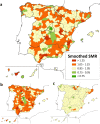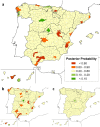A population-based study of mortality due to muscular dystrophies across a 36-year period in Spain
- PMID: 35260676
- PMCID: PMC8904487
- DOI: 10.1038/s41598-022-07814-z
A population-based study of mortality due to muscular dystrophies across a 36-year period in Spain
Abstract
Muscular dystrophies (MD) are a group of rare hereditary degenerative diseases. Our aim was to analyze the mortality pattern in Spain from 1981 to 2016 to assess the temporal trend and discern possible geographic differences using population-based data. Annual deaths related to MD were obtained from the National Statistics Institute with codes 359.1 of the ICD-9 (1981-1998) and G71.0 of the ICD-10 (1999-2016). Age-adjusted mortality rates were calculated and changes in mortality trends were identified. The standardized mortality ratios (SMR) and their respective 95% confidence intervals were calculated by district for 1999-2016. Smoothed SMRs and posterior probability were also assessed and then mapped to look for patterns or geographic distribution. All rates were expressed per 1,000,000 inhabitants. A total of 2,512 deaths (73.8% men) were identified. The age-adjusted mortality rates varied from 0.63 (95% CI 0.40-0.95) in 1981 to 1.51 (95% CI 1.17-1.93) in 2016. MD mortality showed a significant increase of 8.81% per year (95% CI 5.0-12.7) from 1981 to 1990, remaining stable afterwards. Areas with risk of death higher than expected for Spain as a whole were identified, not showing a specific regional pattern. In conclusion, the rising trend in MD mortality might be attributable to advanced improvements in diagnostic techniques leading to a rise in prevalence. Further research on the districts with the highest mortality would be necessary.
© 2022. The Author(s).
Conflict of interest statement
The authors declare no competing interests.
Figures



References
-
- Do TN, Street N, Donnelly J, Adams MM, Cunniff C, Fox DJ, et al. Muscular Dystrophy Surveillance, Tracking, and Research Network pilot: Population-based surveillance of major muscular dystrophies at four U.S. sites, 2007-2011. Birth Defects Res. 2018;110(19):1404–1411. doi: 10.1002/bdr2.1371. - DOI - PMC - PubMed
Publication types
MeSH terms
LinkOut - more resources
Full Text Sources
Medical

